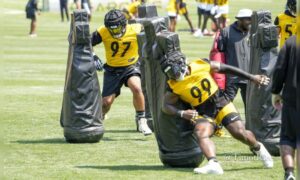Over the course of the past four seasons, ever since their most recent appearance in the Super Bowl, the Pittsburgh Steelers’ defense has been on the decline, though it hasn’t always been represented in the base statistics.
In 2014, for example, the Steelers actually finished with a top 10 rushing defense if you consider the total amount of yardage that they gave up on the ground over the course of the regular season. They gave up, on average, just a bit more than 100 yards per game. Only five teams gave up less yardage on the ground per game.
But what that statistic doesn’t tell you is that the Steelers only faced 23 rushes per game, or 368 over the course of the entire season, which was the third-least throughout the entire league.
The more telling statistic is their yards per carry allowed. They gave up 1605 yards on the ground on those 368 attempts, which translates to an average of 4.36 yards per carry. That placed them in the bottom 10 of the league in that category—eighth from the bottom, to be exact. The vast majority of the other teams who faced the fewest carries against presented much more resistance.
So why did the Steelers see so few carries, comparatively, when they gave up so much on the ground? For one, the fact that they gave up 11 explosive plays on the ground did not help that average. But the bigger factor is opponents’ success through the air.
But the two are not mutually exclusive. For one, opponents ran with success on first and second down, which set them up for success through the air on third down. On the first two downs, which accounted for 321 of opponents’ carries, teams averaged 4.37 yards per carry.
That produces a lot of easily convertible third and short situations, and on later downs, forces the Steelers to sell out against the run more dramatically, which continues to open things up even further to exploit the defense through the air.
So what exactly were the issues with the run defense last year—what must change in order for the Steelers to be less vulnerable against the run? I’ll give out an early hint and say that it’s not replacing Steve McLendon at nose tackle, who, along with Lawrence Timmons, makes up the team’s run-stuffing nucleus.
Part of the problem, of course, was transition. While he played on both sides, for example, Cameron Heyward moved full-time to right defensive end. At left defensive end was Cam Thomas, a free agent signing who underperformed significantly, and was a major contributor to the team’s issues in stopping the run in his direction.
Exacerbating the issue was Jason Worilds’ inconsistency in playing strong run defense from game to game. Putting the two together on a bad day meant a good game for the opposing offense.
The instability at inside linebacker next to Timmons was also a recurring theme, but the missed tackles in the secondary, both from the cornerbacks and the safeties, also really hurt on the perimeter.
Now, some of things will change, or have already changed—Worilds has retired and Stephon Tuitt replaced Thomas in the starting lineup, for example—but there’s no finished product here. While the defense may have the makings of an improved unit against the run, they will need to put the work in. With all of the turnover at the second and third levels, however, there’s no guarantee that it can all get done in time for this season.








